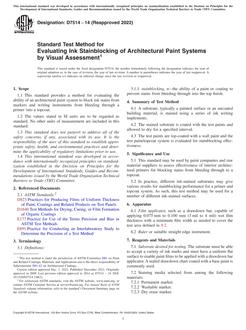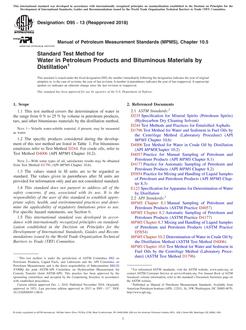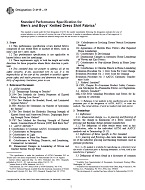1.1 This specification provides a characterization of the design and mechanical function of external skeletal fixation devices (ESFDs), test methods for characterization of ESFD mechanical properties, and identifies needs for further development of test methods and performance criteria. The ultimate goal is to develop a specification, which defines performance criteria and methods for measurement of performance-related mechanical characteristics of ESFDs and their fixation to bone. It is not the intention of this specification to define levels of performance or case-specific clinical performance of the devices, as insufficient knowledge is available to predict the consequences of the use of any of these devices in individual patients for specific activities of daily living. Furthermore, it is not the intention of this specification to describe or specify specific designs for ESFDs.
1.2 This specification describes ESFDs for surgical fixation of the skeletal system. It provides basic ESFD geometrical definitions, dimensions, classification, and terminology; material specifications; performance definitions; test methods; and characteristics determined to be important to the in-vivo performance of the device.
1.3 This specification includes a terminology and classification annex and five standard test method annexes as follows:
1.3.1 Classification of External Fixators – Annex A1.
1.3.2 Test Method for External Skeletal Fixator Connectors – Annex A2.
1.3.3 Test Method for Determining In-Plane Compressive Properties of Circular Ring or Ring Segment Bridge Elements – Annex A3.
1.3.4 Test Method for External Skeletal Fixator Joints – Annex A4.
1.3.5 Test Method for External Skeletal Fixator Pin Anchorage Elements – Annex A5.
1.3.6 Test Method for External Skeletal Fixator Subassemblies – Annex A6.
1.3.7 Test Method for External Skeletal Fixator/Constructs Subassemblies – Annex A7.
1.4 A rationale is given in Appendix X1.
1.5 The values stated in SI units are to be regarded as standard. No other units of measurement are included in this standard.
1.6 The following safety hazards caveat pertains only to the test method portions (Annex A2-Annex A6):
1.7 This standard does not purport to address all of the safety concerns, if any, associated with its use. It is the responsibility of the user of this standard to establish appropriate safety and health practices and determine the applicability of regulatory limitations prior to use.
A1.1.1 This classification covers the definitions of basic terms and considerations for external skeletal fixation devices (ESFDs) and the mechanical analyses thereof.
A1.1.2 It is not the intent of this classification to define levels of acceptable performance or to make recommendations concerning the appropriate or preferred clinical usage of these devices.
A1.1.3 This standard does not purport to address all of the safety concerns, if any, associated with its use. It is the responsibility of the user of this standard to establish appropriate safety and health practices and determine the applicability of regulatory limitations prior to use.
A2.1.1 This test method covers the procedures for determining the stiffness and strength of connecting elements (clamps) of external skeletal fixators under axial loads and bending moments. Depending on the design of the connector and its use in the overall construct, the connector needs to transmit one or more components of loading (tension, compression, torsion, or bending, or a combination thereof) between the elements it grips (anchorage elements or bridge elements), without itself undergoing either permanent deformation or excessive elastic deformation.
A2.1.2 This standard does not purport to address all of the safety concerns, if any, associated with its use. It is the responsibility of the user of this standard to establish appropriate safety and health practices and determine the applicability of regulatory limitations prior to use.
A3.1.1 This test method covers the test procedure for determining the in-plane compressive properties of circular or ring segment bridge elements of external skeletal fixators.
A3.1.2 This standard does not purport to address all of the safety concerns, if any, associated with its use. It is the responsibility of the user of this standard to establish appropriate safety and health practices and determine the applicability of regulatory limitations prior to use.
A4.1.1 Depending on its design and its use in the overall construct, the joint of an external skeletal fixator needs to transmit one or more components of loading (tension, compression, torsion, or bending, or a combination thereof) between the elements it grips (anchorage elements or bridge elements), without either the connector itself or its gripping interface(s) undergoing either permanent deformation or excessive elastic deformation.
A4.1.2 This test method covers the procedures for determining the stiffness and strength of external skeletal fixator joints under axial loads and bending moments.
A4.1.3 This document also covers procedures for determining the range of adjustability in degrees of freedom for which the joint’s configuration can be adjusted by the user and procedures for determining the joint’s range of motion in degrees of freedom for which motion is permitted if the fixator is unlocked.
A4.1.4 This standard does not purport to address all of the safety concerns, if any, associated with its use. It is the responsibility of the user of this standard to establish appropriate safety and health practices and determine the applicability of regulatory limitations prior to use.
A5.1.1 This test method covers the procedure for determining the static bending strength and torsional strength of metallic pins used in external skeletal fixation systems. The described method is intended to provide a means of mechanically evaluating pins and not to define acceptable levels of performance. This test method is applicable only to pins made from materials exhibiting linearly elastic behavior. Pins are defined in Annex A1.
A5.1.2 This standard does not purport to address all of the safety concerns, if any, associated with its use. It is the responsibility of the user of this standard to establish appropriate safety and health practices and determine the applicability of regulatory limitations prior to use.
A6.1.1 This test method covers procedures for determining the stiffness and strength of external skeletal fixator subassemblies, under force loadings (axial, medial-lateral shear, anterior-posterior shear), or under moment loadings (torsion, medial-lateral bending, anterior-posterior bending), or a combination thereof.
A6.1.2 This standard does not purport to address all of the safety concerns, if any, associated with its use. It is the responsibility of the user of this standard to establish appropriate safety and health practices and determine the applicability of regulatory limitations prior to use.
A7.1.1 This test method covers procedures for determining the stiffness, strength, and repetitive loading performance characteristics of external skeletal fixator-bone constructs when subjected to force loading (axial, medial-lateral shear, anterior-posterior shear) and moment loading (torsion, medial-lateral bending, anterior-posterior bending).
A7.1.2 This test method establishes a universal fixator-bone construct’s minimum configuration and set of laboratory tests for evaluating the external fixator device’s (EFD) basic performance characteristics.
A7.1.3 This standard does not purport to address all of the safety concerns, if any, associated with its use. It is the responsibility of the user of this standard to establish appropriate safety and health practices and determine the applicability of regulatory limitations prior to use.
Product Details
- Published:
- 10/01/2011
- Number of Pages:
- 31
- File Size:
- 1 file , 410 KB


